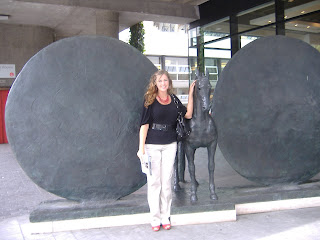
The Museum of London was built in 1976 and used materials from Guildhall and the London Museum in Kensington to start it’s collection. There are three sites comprising the museum: the one we visited near St. Paul’s, which focuses on the urban development of London and employees 150 workers; one in Hackney that deals with archaeological archives; and a third branch near Canary Wharf related to the economic and social history of the London Docklands. The Museum of London is the largest urban museum in the world, and deals with prehistoric through present day London.
Our guide is a curator at the museum and is in charge of the “London Before London” exhibit dealing with the prehistory. His goal was to present four main areas about prehistoric London to visitors: Climate, how it has changed and what that means; The River, how the River Thames is responsible for London being what it is; People, focusing on past residents as individuals not just dead peoples; and Legacy, the legacy that has been passed on to present Londoners. I’ve never really though much about how museums get designed or why they are set up the way they are, but our guide’s talk about how they worked hard to make the exhibit modern but classic, easy to maneuver, chronological, and more, I was struck by the amount of work that has to be done before the actual building begins. Above all, I thought their idea to make one side of the collection blue – to represent the Thames – was a great idea to remind people about the importance of the river.
As far as the collection, I enjoyed that there were items for the public to touch – like a caveman’s club – because it made the item seem more real. I was interested in some of the old jewelry and skulls, but after a while some of the items seemed repetitive. All of the flints and tools started looking the same and started to lose interest. However, I did enjoy the London fire exhibit, especially the six minute video that gave a visual of how much of London was consumed by the blaze. It helped give perspective on how damaging it was to the city. I did think it was funny that the fire started on Pudding Street and ended on Pie Street, and many people thought that was a sign that God started the fire to punish gluttony in London!
Our guide is a curator at the museum and is in charge of the “London Before London” exhibit dealing with the prehistory. His goal was to present four main areas about prehistoric London to visitors: Climate, how it has changed and what that means; The River, how the River Thames is responsible for London being what it is; People, focusing on past residents as individuals not just dead peoples; and Legacy, the legacy that has been passed on to present Londoners. I’ve never really though much about how museums get designed or why they are set up the way they are, but our guide’s talk about how they worked hard to make the exhibit modern but classic, easy to maneuver, chronological, and more, I was struck by the amount of work that has to be done before the actual building begins. Above all, I thought their idea to make one side of the collection blue – to represent the Thames – was a great idea to remind people about the importance of the river.
As far as the collection, I enjoyed that there were items for the public to touch – like a caveman’s club – because it made the item seem more real. I was interested in some of the old jewelry and skulls, but after a while some of the items seemed repetitive. All of the flints and tools started looking the same and started to lose interest. However, I did enjoy the London fire exhibit, especially the six minute video that gave a visual of how much of London was consumed by the blaze. It helped give perspective on how damaging it was to the city. I did think it was funny that the fire started on Pudding Street and ended on Pie Street, and many people thought that was a sign that God started the fire to punish gluttony in London!